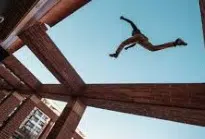 Parkour is a non-competitive physical activity based on people's motor skills . The discipline consists of advancing in a straight line, overcoming terrain obstacles without the use of accessories, supports or accessories of any kind.
Parkour is a non-competitive physical activity based on people's motor skills . The discipline consists of advancing in a straight line, overcoming terrain obstacles without the use of accessories, supports or accessories of any kind.
Whoever practices parkour must develop their ability to move to the maximum, adapting to the environment and avoiding difficulties with their body. Running , climbing and jumping are the most common actions in parkour.
The origins of parkour are linked to the natural training method proposed by the French soldier Georges Hébert ( 1875 – 1957 ), who was inspired by African tribes. Among the first parkour practitioners are the members of the Yamakasi group, such as the actors David Belle and Sébastien Foucan .
Those who do this activity are called traceurs . These athletes perform various pirouettes and acrobatics although, according to the philosophical principles of parkour, they should not put their lives at risk.
Beyond this issue, it is common for them to engage in dangerous actions. Traceurs can jump great distances or from great heights, so they must ensure a safe fall. Injuries , however, are common, especially as more complicated challenges are faced.
With the daily practice of parkour, training allows you to increase agility , flexibility and coordination . Experts in these techniques ensure that individuals of all ages can start the activity, although always according to their physical capabilities. As with any sport , it is important to have a medical check-up before starting routines.
At first glance, a parkour practice gives the sensation of having been created with special effects, since the agility of the traceurs to move through their environment seems impossible for a being of our species. However, like all disciplines, the most impressive displays usually take place after many years of hard training and iron discipline.
Parkour has a very extensive series of movements and techniques, which are divided into three categories: movement, jumping and others . Below we will begin by describing some of those that pertain to displacement:
 * Pasavallas : it is one of the basic movements. Your goal is to overcome the obstacle as efficiently as possible, using only one hand for support. It serves to link two sections of the race without losing speed if there is an element such as a fence in the middle;
* Pasavallas : it is one of the basic movements. Your goal is to overcome the obstacle as efficiently as possible, using only one hand for support. It serves to link two sections of the race without losing speed if there is an element such as a fence in the middle;
* support hurdles : start by going directly towards the obstacle and continue with the support of one hand and the opposite foot so that the movement is fluid;
* change, 180 or demi tour : the hands are used to turn around and remain on your back once you have overcome a fence or wall;
* cat or monkey : a jump that consists of flanking an element using the hands to lean on it parallel along the route, and then passing both bent legs between the arms and the obstacle.
Let's look at some of the most important jumps :
* precision : known in everyday speech as "preci", it does not require prior running and is intended for reception on a wall, a fence or any other narrow space. It can be done with one foot or both;
* distention : the point at which the person lands is at a different level from the start of the jump;
* arm : used to reach with your arms some point that is impossible to reach simply with your feet;
* bottom : done in descending direction. Depending on the inertia towards the front, a rotation may be appropriate.
In the "other" category, the following stand out:
* grimpeo : to go over a high wall, you run and kick it to ascend. Once you reach the top, you use your hands to continue;
* plank : used to reach a position in which we can support the weight of the body completely stretched with our hands on a horizontal bar.
